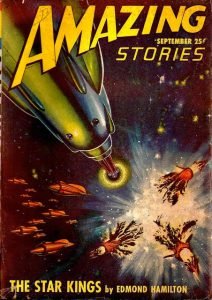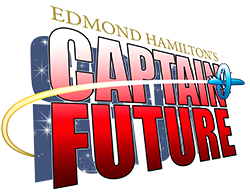About the Creator:
EDMOND HAMILTON
 Edmond Hamilton (1904-1977) is the American writer of science fiction and fantasy credited as being the principal creator of Captain Future as well as being the author of the most of the series’ original novels and stories.
Edmond Hamilton (1904-1977) is the American writer of science fiction and fantasy credited as being the principal creator of Captain Future as well as being the author of the most of the series’ original novels and stories.
Hamilton belonged to the first generation of American science fiction writers, those who wrote short fiction and serialized novels for pulp magazines like Amazing, Astounding, Wonder Stories, and Weird Tales. Although his earliest work ran the gamut from horror to fantasy to near-future “scientifiction” (the earliest term for science fiction), it was together with contemporaries Jack Williamson, Edward E. “Doc” Smith, and Phillip Francis Nowlan that Hamilton invented the subgenre that eventually came to be known as “space opera” — tales of high adventure far away from Earth and distant in the future.
 Hamilton’s novella “Crashing Suns”, published in the August 1928 issue of Weird Tales, is regarded as being one of the keystone works of this new breed of SF, innovative in that it takes place entirely in the 30th century, with no connection at all to the present day. Hamilton followed “Crashing Suns” with more of the same kind of fast-paced, high-concept SF and soon established himself as one of the genre’s leading figures. In acknowledgement of the cosmos-apocalyptic nature of many of those early stories, which bore titles like “The Universe Wreckers”, “The Star-Stealers”, and “Comet Doom”, science fiction fans nicknamed him “World Wrecker Hamilton” (or, alternatively, “World-Saver Hamilton”).
Hamilton’s novella “Crashing Suns”, published in the August 1928 issue of Weird Tales, is regarded as being one of the keystone works of this new breed of SF, innovative in that it takes place entirely in the 30th century, with no connection at all to the present day. Hamilton followed “Crashing Suns” with more of the same kind of fast-paced, high-concept SF and soon established himself as one of the genre’s leading figures. In acknowledgement of the cosmos-apocalyptic nature of many of those early stories, which bore titles like “The Universe Wreckers”, “The Star-Stealers”, and “Comet Doom”, science fiction fans nicknamed him “World Wrecker Hamilton” (or, alternatively, “World-Saver Hamilton”).
Hamilton was one of the most imaginative of science fiction’s early pioneers. This is not surprising, considering his background. His wife Leigh Brackett — one of SF’s first and best female authors — claimed in her introduction to The Best of Edmond Hamilton (see Bibliography elsewhere on this site) that her husband had been a child prodigy, a bibliophile who recalled everything he read. Hamilton entered Westminster College at age 15 to study physics but dropped out three years later, says Brackett, “leaving his professors to wonder why a kid with a genius IQ didn’t do better at his studies.”  Hamilton’s colleague and lifelong friend Jack Williamson, in his introduction to Richard W. Gombert’s World Wrecker: An Annotated Bibliography of Edmond Hamilton (see Bibliography), speculated that his academic career ended without earning a degree was probably because he was bored with academia. Although Hamilton’s early aspiration had been to become an inventor, it was in science fiction instead where he left his mark.
Hamilton’s colleague and lifelong friend Jack Williamson, in his introduction to Richard W. Gombert’s World Wrecker: An Annotated Bibliography of Edmond Hamilton (see Bibliography), speculated that his academic career ended without earning a degree was probably because he was bored with academia. Although Hamilton’s early aspiration had been to become an inventor, it was in science fiction instead where he left his mark.
His story “The Man Who Evolved” (Wonder Stories, April 1931) was one of the first stories to ponder the possible physical changes humankind might go through over the course of millenia. “The Sargasso of Space” (Astounding Stories, Sept. 1931) depicted the first hand-to-hand zero-G fight scene to occur outside a spacecraft, with the two combatants wearing space suits as they duked it out. “What’s It Like Out There?” was one of the very first SF stories to examine space exploration in a unromantic and realistic manner, considered so grim by the standards of 30’s SF that it was not published until 1952, when it finally appeared in Thrilling Wonder decades after Hamilton wrote the original draft but failed to sell it to the pulps of the time.
 Hamilton’s novel The Star Kings, published in Amazing in 1947 and reprinted in 1950 as a Signet paperback retitled Beyond the Moon, is considered by most genre historians to be one of the classic space operas, a swashbuckling adventure in the tradition of Robert Lewis Stevenson, whose work inspired Hamilton’s novel. The Star Kings is Hamilton’s most famous single work, remaining almost constantly in print ever since it was published in book form. Late in his career, Hamilton returned to the characters he created in that novel for a long-awaited sequel, Return to the Stars.
Hamilton’s novel The Star Kings, published in Amazing in 1947 and reprinted in 1950 as a Signet paperback retitled Beyond the Moon, is considered by most genre historians to be one of the classic space operas, a swashbuckling adventure in the tradition of Robert Lewis Stevenson, whose work inspired Hamilton’s novel. The Star Kings is Hamilton’s most famous single work, remaining almost constantly in print ever since it was published in book form. Late in his career, Hamilton returned to the characters he created in that novel for a long-awaited sequel, Return to the Stars.
Hamilton’s career lasted over forty years and included a long stint during the 1950’s as a writer for DC comics, scripting Superman, Batman, and the Legion of Superheroes. He also continued to write original paperback SF, including notable later novels such as The Haunted Stars and City at World’s End. His last great space adventure opus, the three-volume Star Wolf series, was the last of his work published published in his lifetime, sadly left unfinished at the time of his death in 1977.
In spite of his long bibliography and his status as one of American science fiction’s founding fathers, Hamilton is best remembered today for his Captain Future novels and stories (the history of which is told elsewhere on this site). Although much-maligned in their time, the adventures of Captain Future and the Futuremen have had remarkable staying power, outlasting even. Translated worldwide and the basis for a classic Japanese anime series, Captain Future is regarded today as one of the great characters of science fiction’s pulp era.



